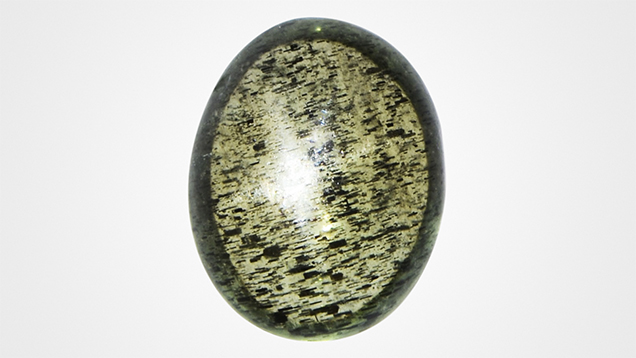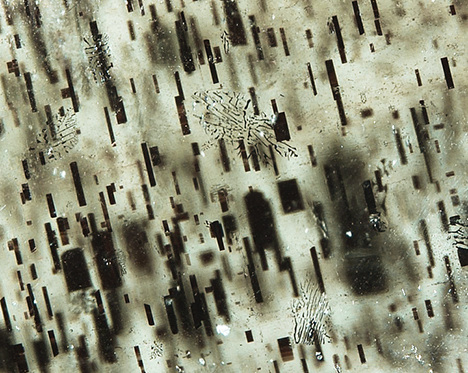Magnetite Inclusions in Star Peridot

The Tokyo lab received a transparent yellow-green peridot displaying four-rayed asterism (figure 1). The 2.71 ct stone, measuring 9.94 × 7.88 × 4.08 mm, was reportedly from Myanmar. It had a spot refractive index of 1.64 and an SG of 3.29 and was identified as terrestrial peridot, which can be distinguished from pallasitic peridot by trace element concentrations.


The asterism of this stone was created by light reflecting from dark, rectangular platelets and needles (figure 2), which were visible without magnification. These were identified as magnetite by Raman spectroscopy (figure 3), namely the three broad bands at around 300, 530, and 670 cm–1 (e.g., O.N. Shebanova and P. Lazor, “Raman spectroscopic study of magnetite (FeFe2O4): A new assignment for the vibrational spectrum,” Journal of Solid State Chemistry, Vol. 174, No. 2, 2003, pp. 424–430), and its reaction to a magnet. These inclusions conforming to one crystallographic plane of the peridot were exsolution lamellae, which are interpreted to have formed by the exsolution of an iron-oxide component from the host peridot (olivine) by subsolidus reaction during cooling and/or decompression. (e.g., R.Y. Zhang et al., “Magnetite lamellae in olivine and clinohumite from Dabie UHP ultramafic rocks, central China,” American Mineralogist, Vol. 84, No. 4, 1999, pp. 564–569). The inclusions in this peridot were larger and seemed to have a different shape from those in previously reported Burmese peridot (Spring 2020 Gems News International, pp. 159–160), which were more acicular. Similar inclusions within a star peridot were also reported (Summer 2009 Lab Notes, pp. 138–139) but could not be identified by Raman spectroscopy due to interference from the host peridot. Although magnetite inclusions have been found in olivines (the mineralogical term for peridot) within some ultramafic and metamorphic rocks by petrological and mineralogical studies (e.g., Zhang et al., 1999), it is notable that magnetite exsolution lamellae were identified in this star peridot using a Raman spectrometer. The difference in shape and size of the inclusions, however, could be due to the duration of the actual cooling and/or decompression time from the formation of the stone to its emplacement on the earth’s surface. A longer emplacement time usually allows a longer time for the inclusions to grow larger.



